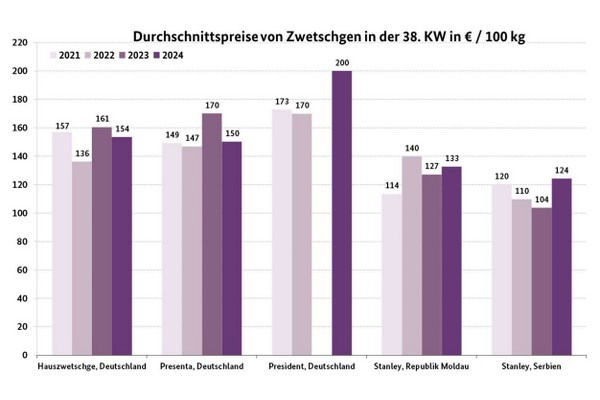Domestic plums predominated, but their presence decreased noticeably in line with the season. Presenta and Hauszwetschge formed the basis of the supply, with various top varieties and President rounding out the offering. Stanley were delivered from the Republic of Moldova and Serbia, which showed some weaknesses in terms of their organoleptic properties and were therefore discounted in some cases. Deliveries from France and Poland completed the product range with small quantities. Despite the reduced availability, the BLE reports that demand was easily met. Interest was mostly declining, with only Berlin reporting improved accommodation options. Prices trended slightly upwards due to limited unloading. Marketing of plums was relatively quiet: The Italian, Spanish and French fruits were received calmly by customers. Slightly higher valuations were sometimes recorded.

Click here to go directly to the full market and price report.
Apples
German offerings dominated the scene, with Elstar, Delbarestivale and Boskoop leading the way. The first domestic Red Jonaprince joined the range, in which Cox Orange and Jonagold had gained in importance. Royal Gala and Granny Smith were the main varieties from Italy.
Pears
Turkish Santa Maria predominated: however, they arrived in Munich and Cologne and had more of a complementary character in the other markets. Abate Fetel and Santa Maria were the main varieties from Italy, while Carmen and Williams Christ lost some of their relevance. Domestic products, on the other hand, gained in importance.
Table grapes
Italian offerings dominated: a large number of varieties were available. The range was led by Italia, Sugraone, Crimson Seedless and Red Globe, but various IFG varieties also played an important role. From Turkey came Sultana and, to a greater extent, Crimson Seedless.
Lemons
South African Eureka lemons obviously dominated and were sometimes available as a monopoly. As a result, they became considerably more expensive in Munich. In Hamburg, the Spanish Primofiori season began: they were much cheaper than the South African competition, which is why they became noticeably cheaper.
Bananas
Supply and demand were sufficiently balanced. Prices therefore did not change significantly in Berlin, Cologne, and Frankfurt. Hamburg reported falling prices for second brands, as these were handled too slowly.
Cauliflower
Availability was rather limited. Quotations for domestic offers rose. In Hamburg, this led to more favourable Danish lots being offered at €9 per grading of 6. In Cologne, Belgian batches arrived on Friday, but only generated a modest response due to their high purchase prices.
Salads
In the iceberg lettuce segment, the presence of Spanish offerings increased noticeably. They were in high demand, as were the leading domestic and complementary Dutch lots. Colourful salads came exclusively from Germany. Lettuce from Germany and Belgium often became more expensive due to limited quantities.
Cucumbers
The high price phase of the previous week weakened slightly: increased availability led to falling prices. Supplies from Spain in particular increased, but Dutch and Belgian offers also became more frequent. Only domestic produce lost market share.
Tomatoes
As in previous weeks, Dutch and Belgian lots dominated. Deliveries from Italy, Poland, Turkey, and Spain only played a minor role. Domestic produce only appeared sporadically and supplemented the marketing. Overall, business was relatively mixed.
Sweet peppers
The presence of the Dutch lots, which set the tone, was evidently limited, while Spanish lots gained in importance. Turkish, Polish and Belgian products had a complementary character. Domestic products also played only a minor role.
Source: BLE
